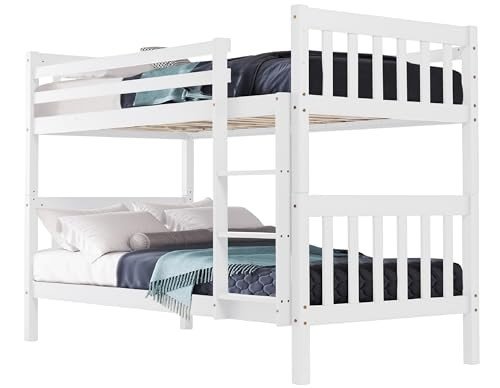The No. #1 Question That Everyone In Bunk Bed Should Be Able To Answer

A Comprehensive Guide to Children's Bunk Beds: Styles, Benefits, and Safety Considerations
Bunk beds have become a popular option for households looking to take full advantage of space and offer an enjoyable sleeping environment for kids. With their unique style, they offer a creative and practical option for shared bedrooms, playrooms, or even guest accommodation. This article checks out the different styles of kids's bunk beds, their advantages, safety considerations, and addresses some regularly asked concerns.
The Allure of Bunk Beds
Children's bunk beds are more than simply space-saving structures; they are also a gateway to adventurous dreams and imaginative play. Below is a detailed evaluation of their many benefits.
Benefits of Bunk Beds
- Space-Saving: Bunk beds effectively use vertical space, making them an ideal choice for smaller rooms.
- Lively Design: Many bunk bed styles consist of slides, camping tents, and themed aspects, triggering creativity and excitement.
- Partner Sharing: Bunk beds are best for siblings sharing a room or accommodating slumber parties.
- Versatile Use: Some designs can be separated into 2 specific beds, using flexibility as children grow.
- Storage Options: Many bunk beds come with built-in drawer storage or shelves, even more improving their usefulness.
Designs of Children's Bunk Beds
The range of bunk beds offered today caters to different choices and requirements. Below is an overview of some popular styles.
| Design | Description | Best For |
|---|---|---|
| Standard Bunk Bed | A standard style featuring one bed stacked above another. | Siblings sharing a room. |
| Loft Bed | Comparable to a bunk bed without the bottom bunk, permits for an office or play location below. | Limited space for play/desk. |
| L-Shaped Bunk Bed | Two beds organized in an L-shape, typically with additional sections for storage or play. | Unique space layouts. |
| Twin Over Full | A twin bed over a complete bed, accommodating different sleep requirements. | Growing children and teens. |
| High Sleeper | Stands even greater than a loft bed, usually including a desk or play location below. | Older kids needing more play/desk space. |
| Tent Bunk Bed | Bunk beds with a canopy or tent-like structure, developing a relaxing, fun space. | Active and creative children. |
Key Features to Consider
When selecting the right bunk bed for kids, the following features are worth thinking about:
- Material: Bunk beds can be made from wood, metal, or a mix. Sale Bunk Bed ibraheemlarsen.top has its unique aesthetic and resilience.
- Weight Capacity: Always verify the weight limitation of the bunk bed to guarantee it can accommodate your kids securely.
- Safety Rails: Ensure the leading bunk has durable rails to prevent falls.
- Ladder Security: A well-designed ladder needs to provide simple and safe access to the upper bunk.
- Completing: Ensure any finishes are non-toxic and safe for kids.
Security Considerations
Security is critical when it concerns children's bunk beds. The following standards ought to be followed:
- Age Appropriateness: Generally, kids under six years of ages need to not oversleep the upper bunk due to safety risks.
- Durable Construction: Ensure the frame and products are solid and can support the weight without sagging.
- Regular Maintenance: Periodically look for loose screws, bolts, or other parts that may require tightening.
- Clear Play Area: Keep the area around the bunk bed totally free of toys and challenges to lessen tripping threats.
Setting Rules for Safe Use
Developing guidelines for bunk bed use will help ensure safety:
- Limit Jumping and Climbing: Children need to be recommended against jumping from the top bunk and getting on the sides.
- Monitoring Sleepovers: Monitor young visitors while they are using the bunk bed for the very first time.
- Educate on Ladder Use: Teach how to use the ladder safely, highlighting the importance of dealing with the ladder when going up or down.
Frequently Asked Questions
1. What age is appropriate for a child to oversleep the leading bunk?
Many producers advise that children ought to be at least 6 years of ages to sleep in the upper bunk. This standard is developed to alleviate the threat of falls.
2. Can bunk beds be customized?
Yes, lots of producers offer personalized alternatives, consisting of colors, materials, and additional features like drawers or desks.
3. Are bunk beds safe for weight?
Bunk beds have weight limitations, normally varying from 200 to 400 pounds, depending upon the model and product. Always check the maker's requirements.
4. How do I maintain and clean a bunk bed?
Routinely look for loose parts, keep the bed clean by cleaning down surfaces, and make sure the bed linen is fresh to promote a safe and sanitary sleep environment.
5. Can bunk beds be separated into individual beds?
Lots of bunk beds come with an alternative to separate them into two specific beds, supplying long-term versatility.
Children's bunk beds are more than simple furniture; they are a practical, versatile, and creative component of a child's space. With numerous designs available and various security considerations to keep in mind, moms and dads can choose the ideal bed that fits their space, meets their kids's needs, and instills a sense of experience. By understanding the benefits, styles, and precaution related to bunk beds, families can create a delightful and protected sleeping environment for their kids. Whether for siblings sharing a room or space-saving solutions, bunk beds stay a cherished option for lots of households.

